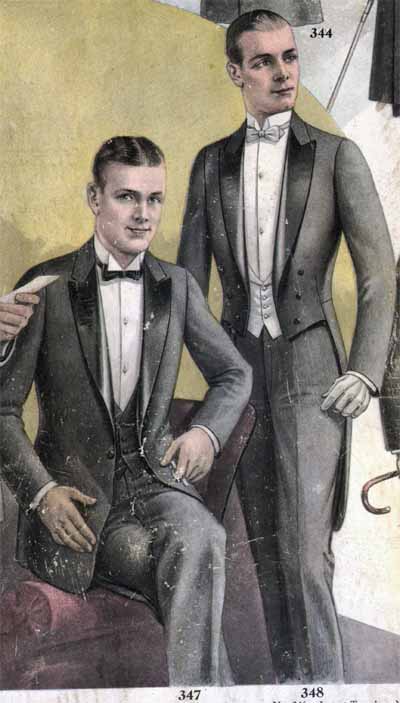
|
Gentlemen’s
Titanic Era
Fashions
an overview of Day
and Evening Wear
by Katy Bishop
|
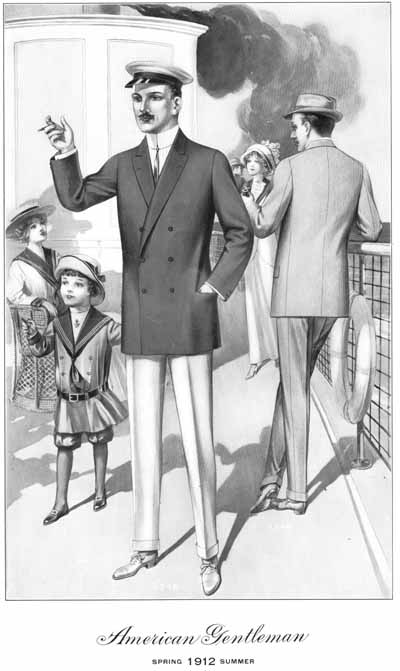
|
|
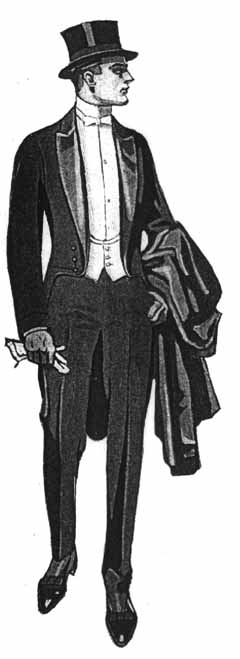
The period of 1910-1912, sometimes called the Titanic Era or Pre War Era
(World War I), saw the end of the Edwardian Age. The changes in menswear were not as
revolutionary as those in ladies’ fashions. This guide introduces evening dress
styles of the early 20th Century to aid in the design and construction
of a period ensemble to wear to a ball, tea or promenade. The details of construction
and cut are what give a gentleman’s outfit a period look.
Visit our
Ladies’ Titanic-era Dress
page for ladies’ fashions.
Please remember that period outfits are not required at most of our events; this page is a guide for
those who wish to further immerse themselves in the period by either putting together a modern
outfit evocative of the period or reproducing an historically accurate outfit.
Evening Dress
Gentlemen’s evening dress of this era is fairly similar to modern formal wear consisting of a
black tail coat or tuxedo jacket, usually with satin faced lapels and pointed front waist. The
Tuxedo is a more informal alternative to the tailcoat. White formal shirts can have standing or
wing tip collars; waistcoats (vests) and bow ties should be either white or black (cummerbunds
had not been invented yet). White waistcoat would generally be worn with tailcoats and black
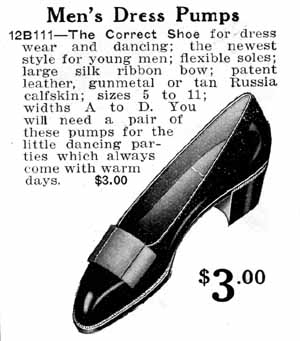 with tuxedo jackets in this period. Illustrated here is a tailcoat suit from 1914 with white
waistcoat and white tie, with top hat and white gloves.
with tuxedo jackets in this period. Illustrated here is a tailcoat suit from 1914 with white
waistcoat and white tie, with top hat and white gloves.
The waistcoat has a low V or curved shield
shaped front opening cut neckline with four or five closely spaced buttons and a pointed waistline.
The trousers, in wool to match the coat, can have black strips
of satin or braid down the outside seams.
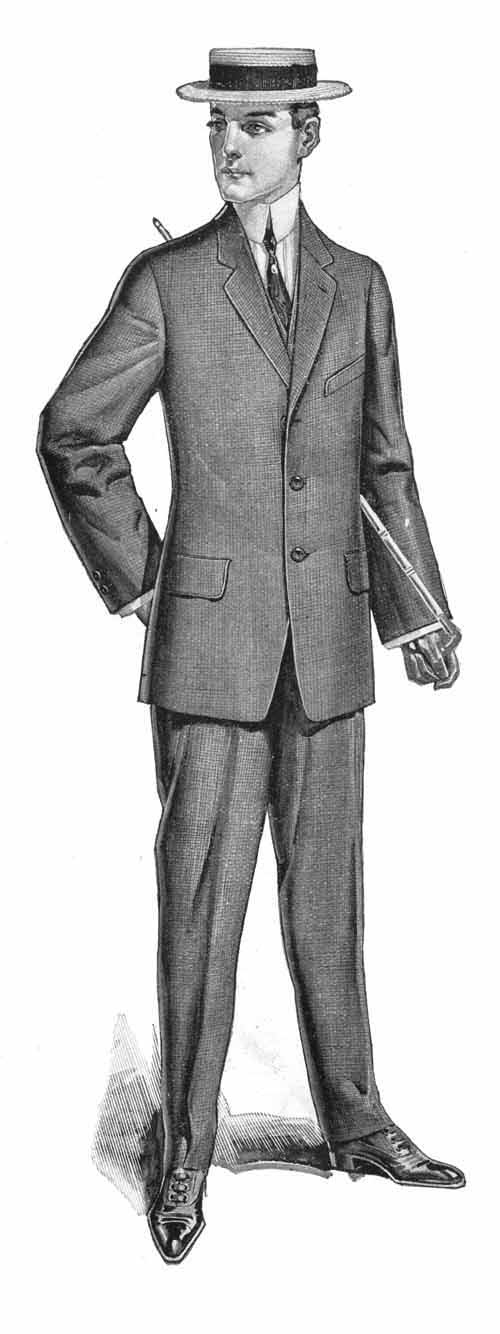 Accessories
Accessories
White gloves add the final touch of formality for ballroom wear.
They should be removed while taking refreshments. Black patent leather dancing pumps would
have been worn in period (illustrated to the left above from Spring/Summer 1912).
A modern alternative is flexible-soled shoes such as Capezio black jazz oxfords. A
black top hat is worn when traveling to or from an evening function, it is removed in the ballroom.
The Fit
The shirt should not be seen below the waistcoat, and the waistcoat should not extend below
the front of the tailcoat. The waistline is much higher than modern trousers. See below for tailoring diagrams of a tailcoat, waistcoat and trousers.
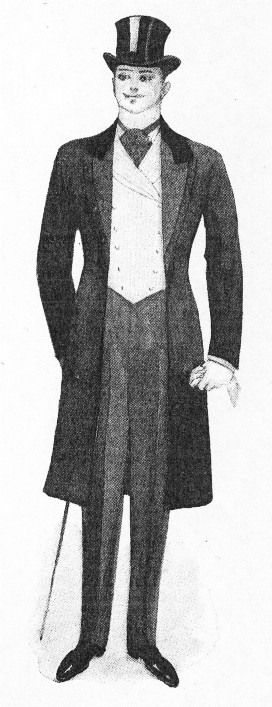 Day Dress
Day Dress
Day wear varied depending on the time of day and formality of occasion. A morning suit
with cut-away coat is very formal for an afternoon tea or wedding. Wool suits are popular and knickers can be worn
for sporting occasions.
The illustration to the left is a morning suit, from 1900, with white or light-colored
waistcoat and ascot tie with a stick-pin. A black top hat is worn. The illustration
to the right is a men's blue serge suit
from a catalogue from the Spring & Summer 1912 season. A straw boater is worn.
The illustration at the lower right
is from Spring/Summer 1912 and illustrates: Two Piece Outing Suit available in
neat stripes and smart mixtures.;
A Blue Serge Coat with Cool Summer Trousers; and Washable Auto Dusters and Covert Dusters
(covert is a twill weave cloth).
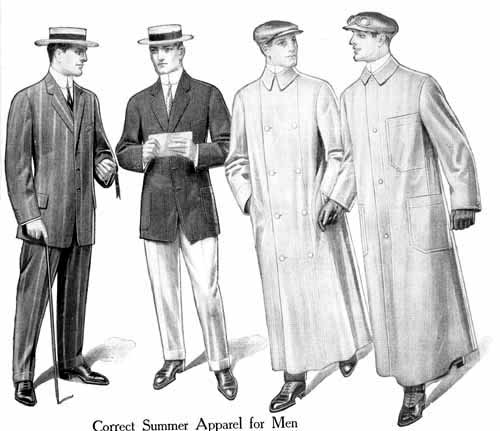
|
ORIGINAL DESCRIPTIONS
This description is from 1911
Proper Dress for All Occasions
For Ball, Theatre, Formal Dinner, Evening Reception or Wedding
Coat and Overcoat—Swallowtail, Cape, Paletot or Chesterfield Overcoat
Waistcoat—White, single-breasted, of pique or silk.
Trousers—Same material as coat; plain seams or soutache braid on outer seams
Hat—High silk with broad felt band or opera hat at theatre.
Shirts and Cuffs—Plain or pleated pique, white with cuffs attached.
Collar— Poke, round tabbed wing or lap front.
Tie—White of plain or figured pique or silk.
Gloves— White glace with self backs or white mocha. White cape for theatre.
Shoes— Patent leather, buttoned, cloth or kid tops or patent leather pumps.
Jewelry—Pearl or moonstone links and studs.
For Afternoon Tea, Church and Promenade
Coat—Morning or frock coat.
Waistcoat— Double or single breasted, same material as coat or of fancy fabric.
Trousers—Striped worsted, light or dark.
Hat— High silk with broad felt band.
Shirt and Cuffs— Plain or pleated, white or fancy, with cuffs attached.
Collar—Fold or wing.
Cravat—Once-over or four-in-hand.
Gloves— Chamois, silk or lisle.
Shoes—Patent leather or calf, buttoned, cloth or kid tops.
Jewelry— Gold or jeweled links, studs and cravat pin.
For Business, Lounge and Morning Wear
Coat—Jacket or walking coat.
Waistcoat—To match coat or of fancy material.
Trousers—If with single-breasted coat, to match; if with double-breasted, of same or different material.
Hat— Straw or soft.
Shirt and Cuffs—Pleated or negligee, colored, with cuffs attached.
Collar—Fold.
Cravat—Four-in-hand or tie.
Gloves— Tan cape, silk or lisle.
Shoes—Laced calf or russet, high or low.
Jewelry—Gold or jeweled links or studs.
For Informal Dinner, at Home Dinner, Club or Stag
Coat—Black or Oxford Dinner Jacket.
Waistcoat—Single-breasted, black, or black and white linen or silk.
Trousers—Same material as jacket, with plain outer seams.
Hat—Straw or Alpine.
Shirt and Cuffs—Pleated, white with cuffs attached.
Collar—Fold or wing.
Tie—Broad end black or black and white silk tie.
Gloves—Chamois, silk or lisle
Shoes— Dull calf, laced tops or gun metal pumps.
Jewelry—Gold or jeweled links and studs.
For Day Wedding, Afternoon Call, Matinee Reception
Coat—Morning or frock coat.
Waistcoat—White linen, duck or silk or to match coat.
Trousers—Striped worsted or cheviot of dark gray.
Hat—High silk with broad felt band.
Shirt and Cuffs—Plain white with cuffs attached
Collar— Poke or round-tabbed wing.
Cravat—Pearl Ascot or once-over to match gloves.
Gloves—Pearl suede to match cravat.
Shoes—Patent leather buttoned, cloth or kid tops.
Jewelry—Pearl or moonstone links, studs and cravat pin.
For Motoring, Golf, Driving, Country
Coat—Norfolk or jacket.
Waistcoat— Fancy flannel with flap pockets.
Trousers—Tweed flannel or to match coat.
Hat— Tweed or worsted cap or panama.
Shirt and Cuffs—Flannel or silk mixture with soft cuffs.
Collar—Fold outing or self-attached collar.
Tie—Neckerchief four-in-hand tie or stock.
Gloves—Chamois, cape or chamoisette. Shoes—Lace calf or russet, high or low.
Jewelry—Pearl or gold links. Leather watchguard.
MEYER BOTH CO. CHICAGO
Leopold Morsello, Boston
From a pamphlet entitled Historic Boston —Leopold Morsello Spring & Summer 1911
This description is from 1915, fairly close to those from 1912
Correct Dress for
EVENING, RECEPTION, WEDDINGS, BALLS, ETC.
COAT AND OVERCOAT: Full Dress Coat, Cape, Inverness or Skirted Coat
WAISTCOAT: White Single-Breasted of Pique Linen or Silk
TROUSERS: Same Material as Coat
HAT: High Silk with Broad Felt Band
SHIRT AND CUFFS: Stiff Pique or Linen White
COLLAR: Wing Poke or Lapfront
CRAVAT: White Tie of Plain or Figured Pique or Linnen (sic)
GLOVES: White Glace or White Reindeer WHite Cape for Theater
BOOTS: Patent Leather Buttoned Kid Tops Patent Leather Pumps
JEWELRY: Pearl or Moonstone Links and STuds Platinum Bar Chain or White Ribbon
From Croonborg's Gazette of Fashions, August 1915
|
|
|
|
SINGLE-BREASTED LONG-ROLL SACK SUIT
Figures 1346 (front)and 1347 (back).
Coat: Single-breasted long roll sack.
Material: White flannel or fancy striped white serge.
Length: For average height (5 ft. 8 ins.) 30 inches.
Shoulders: Moderately narrow, natural finish.
Gorge: Medium depth.
Lapels: Roll to last button, measuring 1 ½ inches at the notch.
Collar: Measures 1 3/8 inches at the notch and 1 ½ inches at the back.
Fronts: Finished soft.
Back: Natural fitting, with or without centre vent.
Pockets: Patched with or without flaps.
Edges: Single-stitched close to edge.
Seams: Plain.
Sleeves: Open vent with one button.
Trousers: Natural fitting at hip and thigh.
Measures: Knee, 19 inches; bottom, 16 inches, with 2 inch cuff.
|
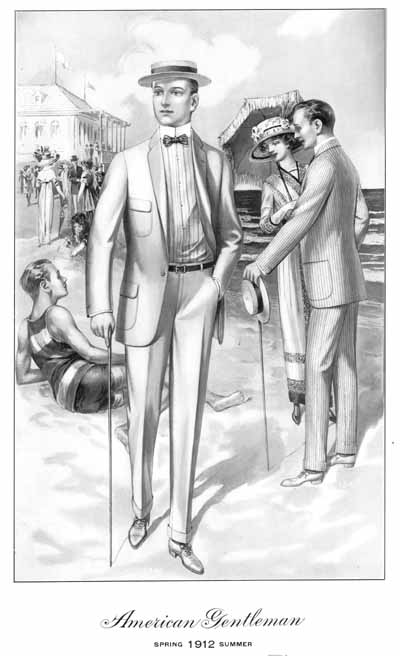
|
|
THREE-BUTTON DOUBLE BREASTED SACK SUIT
Figures 1348 (front) and 1349 (back).
Coat: Three-button double-breasted sack.
Material: Blue serge.
Length: For average heighth (5 ft. 8 ins.) 30 ½ inches.
Shoulders: Moderately narrow, natural finish.
Gorge: Medium depth.
Lapels: Peaked, measuring 2 ¼ inches at the notch, and rolling to second button.
Collar: Measures 1 ½ inches at the notch and the same at the back.
Fronts: Made up soft and closing with three buttons.
Back: Natural fitting, with or without centre vent.
Pockets: Lower pockets with flaps to go in or out.
Edges: Single-stitched close to edge.
Seams: Plain.
Sleeves: Imitation cuff with open vent and two buttons.
Trousers: Same as figure 1346.
Material: White flannel or fancy striped white serge.
|

|
|
|
|
|
|
|
NEWS:






last updated 24 jul 2014/csb
|


